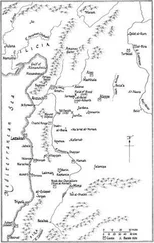Amidst this concert of acclamations and prayers, the Christian army advanced into the plain. To judge only by the state of misery to which they had been reduced, they had rather the appearance of a conquered army than of an army of men marching to victory. A great number of the Crusaders were without clothes. The greater part of the knights and barons marched on foot. Some were mounted on asses and camels, and, what is not an indifferent circumstance on this day, Godfrey de Bouillon had been obliged to borrow a horse of the count de Thoulouse. In the ranks were sick and attenuated soldiers, weakened by famine, and marching with difficulty, who were only supported by the hope of conquering or of dying for the cause of Jesus Christ.
The whole country round Antioch was covered with the Mussulman battalions. The Saracens had divided their army into fifteen bodies arranged in échelons . In the midst of all these, the division of Kerboghâ, says the Armenian historian, appeared like an inaccessible mountain . The Saracen general, who had no expectation of a battle, at first believed that the Christians were come to implore his clemency. A black flag flying over the citadel of Antioch, which was the signal agreed upon to announce the resolution of the Crusaders, soon informed him that he had not to deal with supplicants. Two thousand men of his army, who guarded the passage of the bridge of Antioch, were cut in pieces by the count de Vermandois. The fugitives carried terror to the tent of their general, who was playing at chess. Aroused from his false security, the sultan of Mossoui ordered the head of a deserter to be cut off who had announced to him the speedy surrender of the Christians, and then set himself seriously to the task of fighting an enemy whose auxiliaries were fanaticism and despair.
On marching out of Antioch [127]the Christians advanced westwards towards the spot where the mountains draw near to the Orontes. Ranged in order of battle, in a vast space where the mountains formed a semicircle around them and secured them from surprise, they extended across the plain a league from the city. Hugh, the two Roberts, the count de Belesme, and the count of Hainaut placed themselves at the head of the left wing; Godfrey was on the right, supported by Eustace, Baldwin du Bourg, Tancred, Rinaldo de Toul, and Erard de Puyset. Adhemar was in the centre, with Gaston de Béarn, the count de Die, Raimbaut of Orange, William of Montpellier, and Amanjeu d’Albret. Bohemond commanded a body of reserve, ready to act upon all points where the Christians might require assistance. Kerboghâ, who saw the disposition of the Crusaders, ordered the sultans of Nice, Damascus, and Aleppo, to make the tour of the mountain and then reascend the Orontes, so as to place themselves between the Christian army and the city. He at the same time drew his army up in line of battle to receive the Christians and repulse their attack. He placed his troops partly on the heights and partly on the plain. His right wing was commanded by the emir of Jerusalem, and his left wing by one of the sons of Accien. For himself he remained upon a high hill, to give his orders and watch the movements of the two armies.
At the moment of the commencement of the battle, Kerboghâ was seized with fear, and sent to propose to the Christian princes, that in order to spare the effusion of blood, they should select some of their knights to fight against an equal number of Saracens. This proposal, which had been rejected the day before, could not be adopted by the leaders of an army full of ardour and confident of victory. The Christians entertained no doubt that Heaven had declared itself in their favour, and this persuasion must render them invincible. In their enthusiasm, they looked upon the most natural events as prodigies announcing to them the triumph of their arms. A globe of fire, which on the preceding evening had passed across the horizon and burst over the camp of the Saracens, appeared to them a sign foretelling their victory. As they left Antioch a light rain refreshed the burning air of the climate and the season, and was in their eyes a fresh proof of the favour of Heaven. A strong wind, which assisted the flight of their javelins and impeded that of the arrows of the Turks, was for them as the wind of heavenly anger raised to disperse the infidels. Animated by this persuasion, the Christian army showed the greatest impatience to begin the fight. They marched towards the enemy in perfect order. A profound silence reigned over the plain, on all parts of which shone the arms of the Christians. No sound was heard in their ranks but the voices of the leaders, the hymns of the priests, and the exhortations of Adhemar.
All at once the Saracens commenced the attack by discharging a cloud of arrows and then rushing on the Crusaders, uttering barbarous cries. In spite of their impetuous shock, their right wing was soon repulsed and penetrated by the Christians. Godfrey met with greater resistance in their left wing; he succeeded, however, in breaking it and carrying disorder among their ranks. At the moment that the troops of Kerboghâ began to give way, the sultan of Nice, who had made the tour of the mountain and returned along the banks of the Orontes, fell with impetuosity upon the rear of the Christian army, and threatened destruction to the body of reserve commanded by Bohemond. The Crusaders, who fought on foot, could not resist the first charge of the Saracen cavalry. Hugh the Great, warned of the danger of Bohemond, abandoned the pursuit of the fugitives, and hastened to the succour of the body of reserve. Then the battle was renewed with redoubled fury. Kilidj Arslan, who had to avenge the shame of several defeats as well as the loss of his states, fought like a lion at the head of his troops. A squadron of three thousand Saracen horse, clothed in steel and armed with clubs, carried disorder and terror through the ranks of the Christians. The standard of the count de Vermandois was carried away, and retaken, covered with the blood of Crusaders and infidels. Godfrey and Tancred, who flew to the assistance of Hugh and Bohemond, signalized their strength and valour by the death of a great many Mussulmans. The sultan of Nice, whom no reverse could overcome, firmly withstood the shock of the Christians. In the heat of the combat, he ordered lighted flax to be thrown amongst the low bushes and dried grass which covered the plain. Immediately a blaze arose which enveloped the Christians in masses of flame and smoke. Their ranks were for a moment broken; they could no longer either see or hear their leaders. The sultan of Nice was about to gather the fruits of his stratagem, and victory was on the point of escaping from the hands of the Crusaders.
At this moment, say the historians, a squadron was seen to descend from the summit of the mountains, preceded by three horsemen clothed in white and covered with shining armour. “Behold!” cried Bishop Adhemar, [128]“the heavenly succour which was promised to you. Heaven declares for the Christians; the holy martyrs George, Demetrius, and Theodore come to fight for you.” Immediately all eyes were turned towards the celestial legion. A new ardour inspired the Christians, who were persuaded that God himself was coming to their aid, and the war-cry “ It is the will of God! ” was heard as at the beginning of the battle. The women and children who had remained in Antioch, and were collected on the walls, animated the courage of the Crusaders by their cries and acclamations, whilst the priests continued to raise their hands towards heaven, and returned thanks to God by songs of praise and thanksgiving for the succour he had sent to the Christians. Of the Crusaders themselves each man became a hero, and nothing could stand before their impetuous charge. In a moment the ranks of the Saracens were everywhere broken, and they only fought in confusion and disorder. They endeavoured to rally on the other side of a torrent and upon an elevated point whence their trumpets and clarions resounded; but the count de Vermandois attacked them in this last post and completely routed them. They had now no safety but in flight, and the banks of the Orontes, the woods, the plains, the mountains were covered with the fugitives, who abandoned both their arms and their baggage.
Читать дальше












